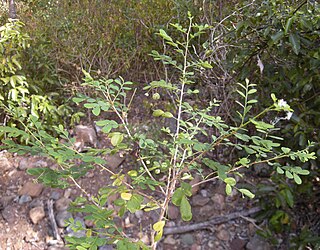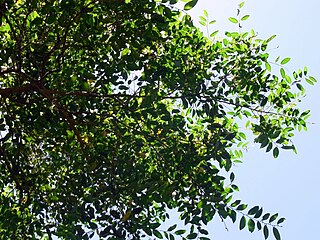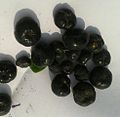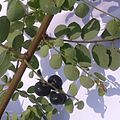
Phyllanthus is the largest genus in the plant family Phyllanthaceae. Estimates of the number of species in this genus vary widely, from 750 to 1200. Phyllanthus has a remarkable diversity of growth forms including annual and perennial herbs, shrubs, climbers, floating aquatics, and pachycaulous succulents. Some have flattened leaflike stems called cladodes. It has a wide variety of floral morphologies and chromosome numbers and has one of the widest range of pollen types of any seed plant genus.

Phyllanthaceae is a family of flowering plants in the eudicot order Malpighiales. It is most closely related to the family Picrodendraceae.

Phyllanthus acidus, known as the Otaheite gooseberry, Malay gooseberry, Tahitian gooseberry, country gooseberry, star gooseberry, starberry, arbari, West India gooseberry, or simply gooseberry tree, is one of the trees with edible small yellow berries fruit in the family Phyllanthaceae. Despite its name, the plant does not resemble the gooseberry, except for the acidity of its fruits. It tastes sour and tart.

The genus Sauropus, of the family Phyllanthaceae, comprises about 40 species of herbs, shrubs or subshrubs, sometimes with woody bases. These plants can be monoecious or dioecious. They are distributed in Southeast Asia, Malesia and Australia.

Omphalea is a plant genus of the family Euphorbiaceae first described as a genus in 1759. It is native to tropical parts of the Americas, the West Indies, Asia, Australia, and Africa.

Bridelia is a plant genus of the family Phyllanthaceae first described as a genus in 1806. It is widespread across Africa, Australia, southern Asia, and various islands of the Indian and Pacific Oceans.

Breynia is a plant genus in the family Phyllanthaceae, first described in 1776. It is native to Southeast Asia, China, the Indian Subcontinent, Papuasia, Australia, and the island of Réunion.

Glochidion is a genus of flowering plants, of the family Phyllanthaceae, known as cheese trees or buttonwood in Australia, and leafflower trees in the scientific literature. It comprises about 300 species, distributed from Madagascar to the Pacific Islands. Glochidion species are used as food plants by the larvae of some Lepidoptera species including Aenetus eximia and Endoclita damor. The Nicobarese people have attested to the medicinal properties found in G. calocarpum, saying that its bark and seed are most effective in curing abdominal disorders associated with amoebiasis.

Drakaea is a genus of 10 species in the plant family Orchidaceae commonly known as hammer orchids. All ten species only occur in the south-west of Western Australia. Hammer orchids are characterised by an insectoid labellum that is attached to a narrow, hinged stem, which holds it aloft. The stem can only hinge backwards, where the broadly winged column carries the pollen and stigma. Each species of hammer orchid is pollinated by a specific species of thynnid wasp. Thynnid wasps are unusual in that the female is flightless and mating occurs when the male carries a female away to a source of food. The labellum of the orchid resembles a female thynnid wasp in shape, colour and scent. Insect pollination involving sexual attraction is common in orchids but the interaction between the male thynnid wasp and the hammer orchid is unique in that it involves the insect trying to fly away with a part of the flower.

Symphyotrichum lateriflorum is a species of flowering plant in the aster family (Asteraceae). Commonly known as calico aster, starved aster, and white woodland aster, it is native to eastern and central North America. It is a perennial and herbaceous plant that may reach heights up to 120 centimeters and widths up to 30 centimeters.

Breynia oblongifolia, commonly known as coffee bush, grows naturally in Australia and New Guinea as shrubs up to 3 m (10 ft) in height. The species produces alternate, distichous, ovate leaves 20–30 mm (0.8–1.2 in) long by 10–20 mm (0.4–0.8 in) wide. Small, green flowers are produced in spring and summer, and these are followed by orange or pink berries about 6 mm (0.24 in) diameter that turn black when fully ripe.

Glochidion ferdinandi, with common names that include cheese tree, is a species of small to medium–sized trees, constituting part of the plant family Phyllanthaceae. They grow naturally across eastern Australia, from south–eastern New South Wales northwards to northern and inland Queensland, in rainforests and humid eucalypt forests. Frugivorous birds such as pigeons, figbirds and parrots consume its fruit.

Epicephala is a genus of moths in the family Gracillariidae.

Glochidion sumatranum known as the umbrella cheese tree is a plant in the family Phyllanthaceae. Although recognized as a distinct species by some sources, others include it within Glochidion zeylanicum. It is found in northern and eastern Australia, New Guinea and Indonesia. The habitat is rainforest, or rainforest margins in swampy areas, sometimes associated with palms. It may grow to 15 metres tall. The most southerly point of natural distribution is Iluka, New South Wales.

Breynia disticha is a plant in the family Phyllanthaceae, first described in 1776. It is native to New Caledonia and Vanuatu in the western Pacific, but naturalized on a wide assortment of other islands around the world, as well as in the U.S. state of Florida.

Tulipa sylvestris, the wild tulip or woodland tulip, is a Eurasian and North African species of wild tulip, a plant in the lily family. Its native range extends from Portugal and Morocco to western China, covering most of the Mediterranean and Black Sea Basins, and Central Asia. The species is also cultivated as an ornamental and naturalized in central and northern Europe as well as a few scattered locations in North America. It was first recorded as being naturalised in Britain in the late 17th century.
Phyllanthus polyspermus is a bush species first described Jean Louis Marie Poiret, with its current name after Schumacher and Thonning; it is included in the family Phyllanthaceae. No subspecies are listed in the Catalogue of Life.

Phyllanthus tenellus is a herbaceous plant in the leafflower family, Phyllanthaceae. It is commonly called Mascarene Island leaf flower as it is native to the Mascarene Islands. It is often a weed in flower beds, gardens, roadsides, and other disturbed areas.

Phyllanthus calycinus, known as false boronia and snowdrop spurge, is a small shrub in the family Phyllanthaceae, which grows to heights from 20 cm to 1.2 m, often on sandy soils. It is found in both Western Australia and South Australia. In Western Australia its white-cream to pink flowers may be seen from June to January, and in South Australia, from May to October.

Symphyotrichum parviflorum is an annual and herbaceous plant commonly known as southwestern annual saltmarsh aster. It is native to Mexico, the Caribbean, most of Central America, Ecuador, and the southwestern United States. It is also known by the scientific name Symphyotrichum expansum.



























